习题答案 (2)
04462设计艺术心理学第二章--《设计艺术心理学发展概述》课后练习题参考答案(2)

《设计艺术心理学》教材版本:柳沙编著清华大学出版社练习题集:第二章设计艺术心理学发展概述一、复习要点及主要概念1.设计艺术心理学的发展线索2.距离说3.实验心理美学4.格雷夫斯的用户心理研究5.感性工学6.有限理性二、问题与讨论1.简要论述工业心理学与人际工程学的发展阶段及发生转变的原因。
2.目前国内外设计艺术心理学研究现状如何?练习题集参考答案及解析一、复习要点及主要概念1.设计艺术心理学的发展线索:(1)心理美学的思想最早起源于哲学家们的思辨。
例如古希腊哲学家柏拉图提出的“迷狂说”,亚里士多德提出的“净化说”,中国古代老子、庄子提出的“虚静说”、“天人合一说”,以及之后出现的“顿悟说”、“意境说”1750年,德国哲学家鲍姆嘉通发表《美学》一书,标志着美学从哲学中分离出来,成为一门独立的学科,但许多重要的美学论断仍是由哲学及所提出来的,他们的美学理论主要是从认识论的高度通过抽象思辨来探讨“美”的本质以及审美活动及其规律等问题;(2)心理美学受到科学心理学影响而倾向实证研究之后,成为了现代科学美学中的重要组成部分,但与行为心理学、认知心理学等心理学分支相比,较重视探索情绪、情感及主体在“审美”活动中的感受、体验,具有较强的主观性;(3)实验心理美学,早期代表人物德国心理学家费希纳将心理实验引入到心理美学研究中,通过心理学实验对各种审美现象进行研究,从他开始,心理美学进入实验心理美学的阶段;(4)20世纪初与实验心理美学同时兴起的重要理论还有“移情说”和“距离说”,也是运用心理学的观点来分析美感和审美体验;(5)20世纪现代心理美学蓬勃发展,精神分析学派对心理美学影响最大,该学派重视无意识,强调无意识对于艺术创作和审美体验的作用;(6)其后,心理美学主要沿着科学心理美学和实验心理美学的路线前进,并且将新尽的心理学理论、知识融入其中;(7)此外,与西方的心理美学流派相比较,俄国心理美学的发展具有特殊性,并且对我国影响较大,如“社会历史文化美学”。
电路基础 (韩春光 著) 电子工业出版社 课后答案 习 题 2-answer

习题22.1在图2.18所示的电路中,求各理想电流源的端电压、功率及各电阻上消耗的功率。
解答:由节点方程得I3=I2-I1=1A,U1=I3R1=1A×20Ω=20V,U2=U1+I2R2=20V+2A×10Ω=40V,P1= U1I1=20V×1A=20W,P2=-U2I2=-80W,电阻上的功率P R1=20V×1A=20W,P R2=20V×2A=40W。
2.2求图2.19所示电路中各支路电流,并计算理想电流源的电压U1。
已知I1=3A,R2=12Ω,R3=8Ω,R4=12Ω,R5=6Ω。
电压和电流的参考方向如图中所示。
解答:节点方程I1+I2+I3=0,I3=I4+I5,网孔方程I2R2=I3R3+I4R4,I4R4=I5R5,联立上述方程得I2=I3=-1.5A,I4=-0.5A,I5=-1A,U1=I2R2=-1.5A×12Ω=-18V。
2.3试用支路电流法求图2.20所示电路中各支路电流,并求三个电源的输出功率和负载电阻RL上的取用功率。
解答:节点方程I1+I2+10=I,网孔方程0.8I1+116=0.4I2+120,0.8I1+4I=120,联立三方程得I1=75/8A,I2=35/4A,I=225/8A,三个电源的输出功率分别为1125W,1015W,1125W;负载电阻上的取用功率为3164.0625W。
2.4用网孔电流法求解习题2.3。
解答:将电流源与负载电阻的位置互换形成三个网孔,网孔参考电流方向均为顺时针方向,网孔电流方程如下1.2I A-0.4I B=120-116,4.4I B-0.4I A-4I C=116,I C=-10A,解得I A=75/8A,I B=145/8A,于是I1=I A=75/8A,I2=I B-I A=35/4A,I=I B-I C=225/8A。
2.5图2.21所示电路,网孔电流如图中所标,试列写可用来求解该电路的网孔方程。
运筹学考试练习题二答案

1、有3个产地4个销地的平衡运输问题模型具有特征( D )A.有7个变量B.有12个约束C.有6约束D.有6个基变量2、X是线性规划的基本可行解则有( C )A.X中的基变量非零,非基变量为零B.X不一定满足约束条件C.X中的基变量非负,非基变量为零D.X是最优解3、设线性规划的约束条件为则基本可行解为(C)A.(0, 0, 4, 3) B.(3, 4, 0, 0) C.(2, 0, 1, 0) D.(3, 0, 4, 0)4、若线性规划问题的最优解同时在可行解域的两个顶点处达到,那么该线性规划问题最优解为(C)A.两个B.零个C.无穷多个D.有限多个5、若原问题中ix为自由变量,那么对偶问题中的第i个约束一定为(A)A.等式约束B.“≤”型约束C.“≥”约束D.无法确定6、若P为网络G的一条流量增广链,则P中所有正向弧都为G的(D )A.对边B.饱和边C.邻边D.不饱和边7、对于线性规划问题,下列说法正确的是(D)A线性规划问题可能没有可行解B在图解法上,线性规划问题的可行解区域都是“凸”区域C线性规划问题如果有最优解,则最优解可以在可行解区域的顶点上到达D上述说法都正确8、在求解运输问题的过程中运用到下列哪些方法(D)A.西北角法B.位势法C.闭回路法D.以上都是二、填空题1、有5个产地5个销地的平衡运输问题,则它的基变量有(9 )个2、设运输问题求最大值,则当所有检验数(小于等于0 )时得到最优解3、线性规划中,满足非负条件的基本解称为(基本可行解),对应的基称为(可行基)。
4、线性规划的目标函数的系数是其对偶问题的(右端常数);而若线性规划为最大化问题,则对偶问题为(最小化问题)。
5、一个(无圈)且(连通)的图称为树。
6、在图论方法中,通常用(点)表示人们研究的对象,用(边)表示对象之间的某种联系。
7、求解指派问题的方法是(匈牙利法)8、求最小生成树问题,常用的方法有:(避圈法)和(破圈法)9、如果有两个以上的决策自然条件,但决策人无法估计各自然状态出现的概率,那么这种决策类型称为(不确定)型决策。
宋天佑无机(二)习题答案
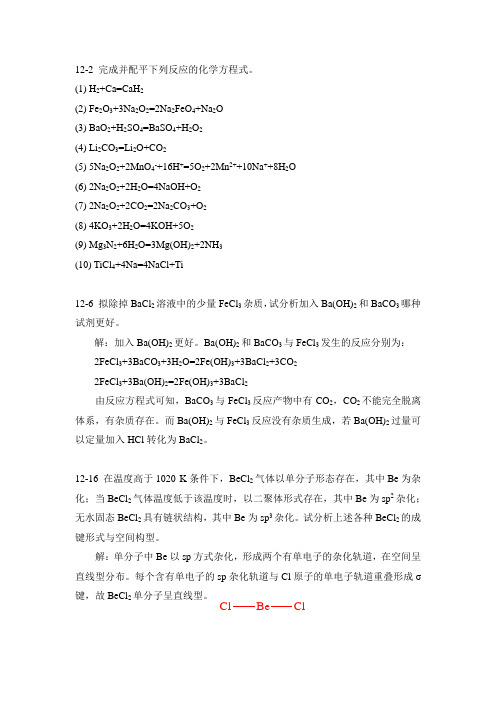
12-2 完成并配平下列反应的化学方程式。
(1) H2+Ca=CaH2(2) Fe2O3+3Na2O2=2Na2FeO4+Na2O(3) BaO2+H2SO4=BaSO4+H2O2(4) Li2CO3=Li2O+CO2(5) 5Na2O2+2MnO4-+16H+=5O2+2Mn2++10Na++8H2O(6) 2Na2O2+2H2O=4NaOH+O2(7) 2Na2O2+2CO2=2Na2CO3+O2(8) 4KO3+2H2O=4KOH+5O2(9) Mg3N2+6H2O=3Mg(OH)2+2NH3(10) TiCl4+4Na=4NaCl+Ti12-6 拟除掉BaCl2溶液中的少量FeCl3杂质,试分析加入Ba(OH)2和BaCO3哪种试剂更好。
解:加入Ba(OH)2更好。
Ba(OH)2和BaCO3与FeCl3发生的反应分别为:2FeCl3+3BaCO3+3H2O=2Fe(OH)3+3BaCl2+3CO22FeCl3+3Ba(OH)2=2Fe(OH)3+3BaCl2由反应方程式可知,BaCO3与FeCl3反应产物中有CO2,CO2不能完全脱离体系,有杂质存在。
而Ba(OH)2与FeCl3反应没有杂质生成,若Ba(OH)2过量可以定量加入HCl转化为BaCl2。
12-16 在温度高于1020 K条件下,BeCl2气体以单分子形态存在,其中Be为杂化;当BeCl2气体温度低于该温度时,以二聚体形式存在,其中Be为sp2杂化;无水固态BeCl2具有链状结构,其中Be为sp3杂化。
试分析上述各种BeCl2的成键形式与空间构型。
解:单分子中Be以sp方式杂化,形成两个有单电子的杂化轨道,在空间呈直线型分布。
每个含有单电子的sp杂化轨道与Cl原子的单电子轨道重叠形成σ键,故BeCl2单分子呈直线型。
ClBe Cl二聚体中,Be 以sp 2方式杂化,形成两个有单电子的杂化轨道和一个空的杂化轨道,杂化轨道为平面三角形。
《随机过程及其在金融领域中的应用》习题二答案
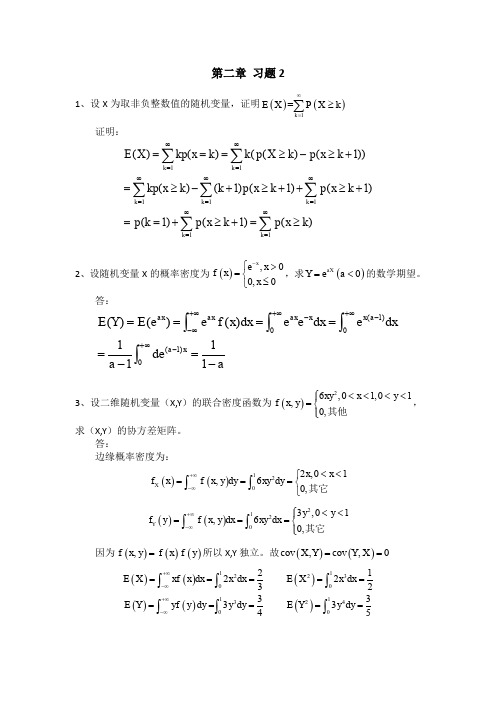
0
sin
ux
f
xdx
0
sin
ux
f
xdx
0
0
sin
u
x
f
xdx
sin ux 0
f
x dx
0
令其中一式中的 x t
0
sin
ut
f
t
d
t
0
sin
ux
f
xdx
0
sin ut 0
证明:
X u
eiux f xdx
cos ux i sin ux f xdx
cos ux
f
xdx
i
sin
ux
f
xdx
(a)充分性:
当f
x
f
x时,sin ux
f
x
为奇函数
,
则i
c o vY Y, E Y 2 E Y 2 3 80
故(X,Y)的协方差矩阵为
cov X , X cov Y , X
1
cov X ,Y cov Y ,Y
18 0
0
3 80
4、已知二维随机变量(X,Y)服从联合正态分布,且
dFX
x
e tx f xdx
etxexdx etxdx
热力学课后习题02答案

第2章 热力学第一定律2-1 定量工质,经历了下表所列的4个过程组成的循环,根据热力学第一定律和状态参数的特性填充表中空缺的数据。
过程 Q/ kJ W/ kJ△U/ kJ1-2 0 100 -1002-3-11080 -1903-4 300 90 210 4-1 20 -60802-2 一闭口系统从状态1沿过程123到状态3,对外放出47.5 kJ 的热量,对外作功为30 kJ ,如图2-11所示。
(1) 若沿途径143变化时,系统对外作功为6 kJ ,求过程中系统与外界交换的热量; (2) 若系统由状态3沿351途径到达状态1,外界对系统作功为15 kJ ,求该过程与外界交换的热量;(3) 若U 2=175 kJ ,U 3=87.5 kJ ,求过程2-3传递的热量,及状态1的热力学能U 1。
图2-11 习题2-2解:(1)根据闭口系能量方程,从状态1沿途径123变化到状态3时,12313123Q U W −=∆+,得1347.5kJ 30kJ 77.5kJ U −∆=−−=−从状态1沿途径143变化到状态3时,热力学能变化量13U −∆保持不变,由闭口系能量方程14313143Q U W −=∆+,得14377.5kJ 6kJ 71.5kJ Q =−+=−,即过程中系统向外界放热71.5kJ(2)从状态3变化到状态1时,()31133113U U U U U U −−∆=−=−−=−∆,由闭口系能量方程35131351Q U W −=∆+,得35177.5kJ 15kJ 62.5kJ Q =−=,即过程中系统从外界吸热92.5kJ(3)从状态2变化到状态3体积不变,323232323232Q U W U pdV U −−−=∆+=∆+=∆∫,因此23233287.5kJ 175kJ 87.5kJ Q U U U −=∆=−=−=−由1331187.577.5kJ U U U U −∆=−=−=−,得1165kJ U =2-3 某电站锅炉省煤器每小时把670t 水从230℃加热到330℃,每小时流过省煤器的烟气的量为710t ,烟气流经省煤器后的温度为310℃,已知水的质量定压热容为 4.1868 kJ/(kg ·K),烟气的质量定压热容为1.034 kJ/(kg ·K),求烟气流经省煤器前的温度。
《误差理论与数据处理》习题2及解答

(mm)
② 重复测量 10 次,计算其算术平均值为: x = 26.2025(mm). 取与①相同的置信度,则测量结果为:26.2025±3σ= 26.2025±0.0015 (mm). ③ 若无该仪器测量的标准差资料,则依 10 次重复测量数据计算标准差和表示测量结 果。选参考值 x0 = 26.202,计算差值 ∆x i = x i − 26.202 、 ∆ x 0 和残差ν i 等列于表中。 序 1 2 3 4 5 6 7 8 9 10 号
∑ν
i =1
i
n( n − 1)
= 1.253
0.0008 5× 4
= 0.000224 (mm)
σx =
σ
n
=
0.000255 5
= 0.000114 ; σ x =
'
σ'
n
=
0.000224 5
= 0.0001
⑤求单次测量的极限误差和算术平均值的极限误差 因假设测量值服从正态分布,并且置信概率 P=2Φ(t)=99%,则Φ(t)=0.495,查附录
∆ x0 = 1 10 ∑ ∆xi = 0.0005 10 i =1
νi
0 +0.0003 +0.0003 0 +0.0001 -0.0003 -0.0002 0 +0.0001 -0.0003
ν i2
0 9×10 9×10 0 1×10
管理会计课后习题学习指导书习题答案(第二章)
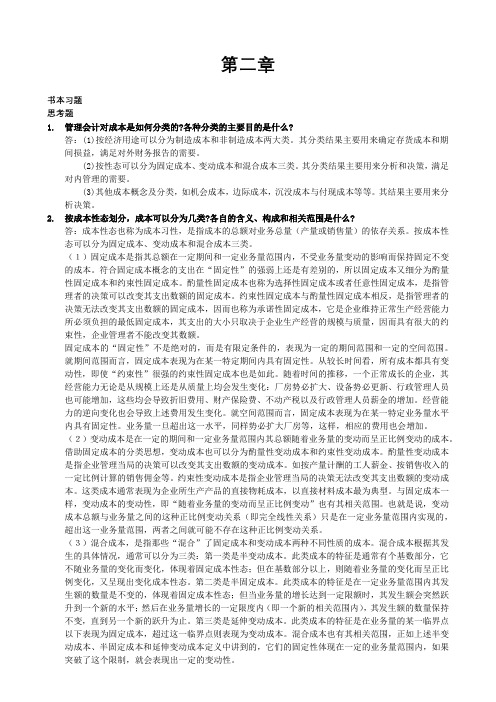
第二章书本习题思考题1.管理会计对成本是如何分类的?各种分类的主要目的是什么?答:(1)按经济用途可以分为制造成本和非制造成本两大类。
其分类结果主要用来确定存货成本和期间损益,满足对外财务报告的需要。
(2)按性态可以分为固定成本、变动成本和混合成本三类。
其分类结果主要用来分析和决策,满足对内管理的需要。
(3)其他成本概念及分类,如机会成本,边际成本,沉没成本与付现成本等等。
其结果主要用来分析决策。
2.按成本性态划分,成本可以分为几类?各自的含义、构成和相关范围是什么?答:成本性态也称为成本习性,是指成本的总额对业务总量(产量或销售量)的依存关系。
按成本性态可以分为固定成本、变动成本和混合成本三类。
(1)固定成本是指其总额在一定期间和一定业务量范围内,不受业务量变动的影响而保持固定不变的成本。
符合固定成本概念的支出在“固定性”的强弱上还是有差别的,所以固定成本又细分为酌量性固定成本和约束性固定成本。
酌量性固定成本也称为选择性固定成本或者任意性固定成本,是指管理者的决策可以改变其支出数额的固定成本。
约束性固定成本与酌量性固定成本相反,是指管理者的决策无法改变其支出数额的固定成本,因而也称为承诺性固定成本,它是企业维持正常生产经营能力所必须负担的最低固定成本,其支出的大小只取决于企业生产经营的规模与质量,因而具有很大的约束性,企业管理者不能改变其数额。
固定成本的“固定性”不是绝对的,而是有限定条件的,表现为一定的期间范围和一定的空间范围。
就期间范围而言,固定成本表现为在某一特定期间内具有固定性。
从较长时间看,所有成本都具有变动性,即使“约束性”很强的约束性固定成本也是如此。
随着时间的推移,一个正常成长的企业,其经营能力无论是从规模上还是从质量上均会发生变化:厂房势必扩大、设备势必更新、行政管理人员也可能增加,这些均会导致折旧费用、财产保险费、不动产税以及行政管理人员薪金的增加。
经营能力的逆向变化也会导致上述费用发生变化。
报关员考试《商品编码》习题及答案详解汇总(二)

报关员考试《商品编码》习题及答案详解汇总(二)1、冻扇贝(供食用)标准答案:0307.2900解析:本题商品是软体动物。
2、活珍珠鸡(供食用,重2千克)标准答案:0105.9993解析:本题商品按品目条文归类。
3、供食用的野鸭标准答案:0106.3923解析:注意确定此题编码时,不要归入01.05,01.05是家禽。
应归入其他活动物,品目0106.3923有具体的列名。
4、仅经过洗涤处理的野鸭羽绒(制羽绒被用)标准答案:0505.1000解析:本题商品按品目条文归类。
5、供食用的活甲鱼标准答案:0106.2020解析:不能按鱼归入第3章。
甲鱼又称鳖,属于水陆两栖爬行动物,归入0106 其他动物,归入0106.2020的品目。
6、供人食用的冷猪肝标准答案:0206.3000解析:属于食用杂碎,因此归入第2章。
查阅章注,章注没有特别说明,因此归入第2章,根据加工程度,归入0206.3000。
7、干海马标准答案:0305.5910解析:海马属于鱼类,不是第一章商品。
8、供食用的冻大闸蟹标准答案:0306.1490解析:本题商品是甲壳动物。
9、鳗鱼苗标准答案:0301.9210解析:鱼苗是活鱼。
10、混合冻鸡杂碎(非供人食用)标准答案:0511.9990解析:非供人食用的动物产品归入第5章。
11、供人食用的鲜猪肠标准答案:0504.0019解析:注意第二章章注二,动物的肠、膀胱、胃,不管是否适合供人食用,都不归入第二章,而是归入第5章。
12、供人食用的冻的鸡胗标准答案:0504.0021解析:鸡胗属于食用杂碎,初步判断归入第二章,再查阅第二章,在第二章的章注二,动物的肠、膀胱、胃,不管是否适合供人食用,都不归入第二章,而是归入第5章。
鸡胗属于鸡的“胃”。
因此归入第5章而不是归入第二章。
13、活墨鱼(非种用)标准答案:0307.4190解析:本题商品是软体动物。
14、活信鸽(非改良种用)标准答案:0106.3990解析:信鸽不是供食用的动物。
核磁共振部分习题及答案_2

NMR problems 2nd part1.Below are the 1H and 13C NMR spectra of 2-hexanone (CH3COCH2CH2CH2CH3). Explain carefully how, using homonuclear and heteronuclear decoupling experiments, you could assign the each of the resonances in the 1H and 13C spectra to which nuclei give rise to them.1H NMR spectra of 2-hexanone13C NMR spectra of 2-hexanoneAnswer This is a commonly encountered problem. You obtain a 1H and a 13C NMR spectrum and need to assign each of the resonances in both 1H and 13C spectra.It is generally straight-forward to assign the 1H spectrum using a combination ofdirect inspection (characteristic chemical shifts and multiplicities) in combination with homonuclear decoupling experiments. For 1H spectra, homonuclear decoupling gives you connectivity (which protons are on adjacent carbon atoms) because 1H is 100% abundant. Note that homonuclear decoupling cannot be used for 13C spectra because 13C is isotopically dilute there essentially no possibility that there will be 2 13C nuclei adjacent to each other in an organic molecule.For 2-hexanone, the 1H spectrum contains 5 resonances. You would expect to see one singlet (integral 3H) for the CH3 group attached to the ketone (ie at C1). The CH2 group adjacent to the ketone (ie at C3) would appear as a triplet (with coupling to the adjacent CH2. The CH2 at C4 would appear as a multiplet (a triplet of triplets with coupling to both the CH2 at C3 and the CH2 at C5). Likewise the CH2 at C5 would appear as a multiplet (a triplet of quartets with coupling to both the CH2 at C4 and the CH3 at C6). The resonance of the CH3 at C6 would be a triplet (integral 3H). Intuitively, you would also expect the CH3 and CH2 groups adjacent to the carbonyl to occur at low field (between 1.5 and 2.5 ppm) and the CH3 at C6 to be at high field (between 0.5 and 1 ppm). By inspection, you can assign the proton signals for C1 (δ 1.7), C3(δ 1.9) and C6(δ 0.8). The multiplet signals atδ1.1 andδ 1.3 must belong protons at C4 and C5 and to distinguish these you would use homonuclear decoupling experiments. If the protons at C3 (δ 1.9) are irradiated, the multiplet due to protons at C4 would collapse from a triplet of triplets to a triplet and hence its shift would be known. Similarly, if the protons at C6 (δ 0.8) were irradiated, the multiplet due to protons at C5 would collapse from a triplet of quartets to a triplet and hence its shift would be known.Having assigned the 1H spectrum, the 13C spectrum can be assigned using selective heteronuclear decoupling experiments.The 13C spectrum contains 6 resonances, the resonance due to the carbonyl carbon is obvious from its shift. For the remaining 5 carbons you would expect to have signals from 2 x CH3 and 3 x CH2 groups and in the absence of any 1H decoupling these would appear as 2 quartets and 3 triplets. In the heteronuclear decoupling experiment you would irradiate each of the resonances in the 1H spectrum and observe the 13C spectrum. As each of the 1H signals is irradiated, the resonance of the 13C coupled to it would collapse to a singlet - the multiplicity of the other signals would remain essentially unchanged.The correlation of 1H and 13C NMR spectra can also be achieved using two-dimensional NMR using a heteronuclear shift correlation (HSC) experiment.2.The simple molecules below contain the NMR-active nuclei 14N (I=1), 31P (I=1/2), 1H (I=1/2) and 13C (I=1/2). Considering only the coupling constants through one bond (1J ax) as being significant, construct diagrams which schematically represent the splitting pattern you would see in :1The 1H NMR spectrum of the ammonium ion [N H4+].2The 14N NMR spectrum of the [N H4+].3The 13C NMR spectrum of trimethylamine [(C H3)3N]4The 31P NMR spectrum of phosphine [P H3].5The 1H NMR spectrum of phosphine [P H3].6The 13C NMR spectrum of H2P-C H2-PH2.7The 13C NMR spectrum of [(PH2)3C H].Answer This is simply an exercise in predicting the multiplicity observed using the formula: multiplicity = 2nI + 1.1The 1H NMR spectrum of CH4 will be a singlet (no multiplicity) since the molecule is tetrahedral in shape and all of the protons are equivalent. There is no coupling from carbon since almost all C is 12C and this is NMR silent.2The 13C NMR spectrum of CH4 is a quintet. The C is coupled to 4 equivalent protons and the spin of 1H is ½.(2nI + 1) = (2 x 4 x ½) + 1 = 53The 1H NMR spectrum of NH4+ will have 3 lines. The molecule is tetrahedral in shape and all of the protons are equivalent and these will be coupled to 14N (which has a spin I = 1).(2nI + 1) = (2 x 1 x 1) + 1 = 34The 14N NMR spectrum of NH4+ is a quintet. The 14N is coupled to 4 equivalent protons and the spin of 1H is ½.(2nI + 1) = (2 x 4 x ½) + 1 = 55The 1H NMR spectrum of PH3 is a doublet. The molecule (like ammonia) is pyramidal and all 3 protons are equivalent. The protons (with spin I = ½) are coupled to one 31P nucleus.(2nI + 1) = (2 x 1 x ½) + 1 = 26The 31P NMR spectrum of PH3 will have 4 lines (quartet). The molecule is pyramidal in shape and all of the protons are equivalent (with a spin I = ½). and these will be coupled to 31P.(2nI + 1) = (2 x 3 x ½) + 1 = 47The 13C NMR spectrum of H2PCH2PH2 will be a triplet of triplets. The 13C will be coupled to 2 x 31P (giving a triplet splitting) and the 13C will be coupled to 2 x 1H (giving a triplet splitting).8The 13C NMR spectrum of (H2P)3CH will be a doublet of quartets. The 13C will be coupled to 3 x 31P (giving a quartet splitting) and the 13C will be coupled to 1 x 1H (giving a doublet splitting).3 The 1H NMR spectrum of (E)-2-pentenal (given below) has 5 distinct resonances: δ9.5 (1H, doublet), δ 6.9 (1h, doublet of triplets), δ 6.0 (1H, doublet of doublets), δ 2.2 (2H, multiplet) and δ 1.0 (3H, triplet). Sketch and clearly describe the 1H spectra you would obtain while applying strong Rf. irradiation at :1δ9.52δ 6.93δ 6.04δ 2.25δ 2.26δ 1.0Answer The signals in the spectrum can be readily assigned by inspection: •δ 9.5 is due to the aldehydic proton - it appears as a doublet due to coupling with the vinylic proton on the adjacent carbon.•δ 6.0 is due to the vinyl proton at C2. It appears as a doublet of doublets with one doublet splitting due to the aldehyde proton and the other doublet splitting due to the vinylic proton at C3.•δ 6.9 is due to the vinyl proton at C3. It appears as a doublet of triplets with the doublet splitting due to the vinylic proton at C2 and the triplet splitting due to coupling to the CH2 group at C4.•δ 2.2 is due to the CH2 group at C4. It appears as a multiplet but must be adoublet of quartets with the doublet splitting due to coupling to the vinylic proton at C3 and the quartet splitting due to the CH3 group at C5.•δ 1.0 is due to the CH3 group at C5. It appears as a triplet due to coupling to the CH2 group at C4 (δ 2.2).The effect of irradiation at each of these frequencies is to decouple the nuclei which have signals at these frequencies. Decoupling effectively removes the nucleus from the spin system.1 With irradiation at δ 9.5, the multiplicity of the vinylic CH resonance at δ 6.0is simplified from a doublet of doublets to a doublet. The remaining resonances in the spectrum are unchanged.2With irradiation at δ 6.9, the multiplicity of the vinylic CH resonance at δ 6.0 is simplified from a doublet of doublets to a doublet and the CH2 resonance at C4 (δ 2.2) is simplified from a doublet of quartet to a simple quartet. The remaining resonances are unchanged.3With irradiation at δ 6.0, the multiplicity of the vinylic CH resonance at δ 6.9 is simplified from a doublet of triplets to a simple triplet and the resonance of the aldehyde proton is simplified from a doublet to a singlet.4With irradiation at δ 2.2, the multiplicity of the vinylic CH resonance δ 6.9 is simplified from a doublet of triplets to a simple doublet and the multiplicity of the CH3 resonance (δ 1.0) is simplified from a triplet to a singlet.5With irradiation at δ 1.0, the multiplicity of the CH2 group at C4 (δ 2.2) is simplified from a doublet of quartets to a simple doublet. The remaining resonances in the spectrum are unchanged.4.The 1H NMR spectrum of 1,4-dioxan-d7 at room temperature consists of a singlet (with broadband decoupling of 2H). At -150o C the spectrum appears as two singlets of equal intensity. Using your knowledge about the conformation (and conformational mobility) of 6-membered rings, give a rationalisation as to why the room temperature and low temperature spectra appear as they do.Answer 1,4-dioxan is a 6-membered ring and adopts a chair conformation (like other 6-membered rings such as cyclohexane). In the chair conformation, there are two proton environments and protons can be either axial or equatorial. At room temperature, rapid ring flipping causes protons to exchange between axial and equatorial sites so the proton spectrum is a singlet.In 1,4-dioxan-d7, seven out of the 8 protons have been substituted deuterium, leaving only 1 proton. Again this proton would be expected to be in either the axial or equatorial position and at low temperature (slow exchange) the protons in axial positions will have a different chemical shift to protons in the equatorial sites.At low temperature where the ring flip is slow, there will be molecules with the single proton axial some with the proton equatorial. There would be two signals one corresponding to axial protons and one corresponding to equatorial protons. The fact that these signals are of approximately equal in intensity indicates that there is no significant thermodynamic preference to have the proton to be equatorial or axial.At high temperature, the ring flip is rapid and the proton is rapidly exchanged between axial and equatorial sites and the shift is averaged to a single resonance at a shift half way between the signals between the signals in the slow exchange spectrum.5.The 1H free induction decay (FID) was acquired following a single 90o pulse to a sample of chloroform (CHCl3). The spectrum following Fourier transformation (FT) is given on the right.Describe what would happen to the FID and to the spectrum obtained following FT when :1The pulse angle was increased to 150o.2 A small amount of an Fe(III) salt was dissolved in the solution before acquisitionof the FID.316 FIDs were accumulated and added together before FT.4 A second FID was acquired using a 270o pulse instead of a 90o pulse and added tothe first before FT.5The sample was dissolved in a viscous solvent before acquisition of the FID.6The FID was accumulated for twice the acquisition time before FT.7The proton spectrum was saturated for several seconds immediately before (but not during) the acquisition of the FID.What would happen to the spectrum if 16 FIDs were accumulated, each wastransformed and the resulting spectra were added together to give the final spectrum ? Answer The 1H FID and spectrum are derived from a sample of CHCl3.1The response of the sample is a sinusoidal function of the pulse angle. Sin(90) = 1 and Sin(150) = Sin(30) = ½ so the intensity of the signal in the FID and in the spectrum will be decreased by a factor of 2.2Addition of a small amount of a paramagnetic salt will increase the efficiency of relaxation. Nuclei would be expected to relax more quickly and this would be reflected in a change in the appearance of the FID and the spectrum. The signal in the FID would decay to zero more rapidly (i.e. in less time); signals in the spectrum would be broader.3The signal-to-noise ratio (S/N) of the spectrum increases as the square root of the number of acquisitions that are added together. If 16 acquisitions are added the S/N increases by a factor of √ 16 = 4.4If an FID was accumulated with a 270o pulse, it would be a mirror image (about the zero level in the FID) of the FID accumulated with a 90o pulse. This means that at every point where the 90o FID was above zero, the 270o FID would be below zero and addition of the 90o and 270o FID's would mean that the signals would exactly cancel - only noise would remain. The spectrum would contain only noise.5 A viscous solvent will slow the rate of molecular tumbling and this in turnincreases the efficiency of relaxation. Nuclei would be expected to relax more quickly and this would be reflected in a change in the appearance of the FID and the spectrum. The signal in the FID would decay to zero more rapidly (ie in less time); signals in the spectrum would be broader.6The FID as presented has clearly decayed to zero well before the accumulation of the FID has stopped. By the end of the acquisition time, there is no signal only noise being accumulated. Increasing the acquisition time by a factor of two will double the time for which the FID signal is accumulated however the real signal in the FID will still decay at the same rate so the real signal will be proportionally less of the FID and there would be proportionally more noise. In the spectrum, the S/N would be decreased.7Saturation of the 1H spectrum would mean that the 1H spectrum would not be observable, providing there was no significant delay between the saturation and recording the FID. Nuclei take several T1's to recover following saturation.8If 16 FIDs were accumulated then each transformed and the spectra added, there would be no difference to the situation where 16 FID's were added and the summed FID was transformed. In practice since the FT actually takes some time it is more time-economical to minimise the number of tiems that the FT has to be performed.6.The 13C NMR spectrum of 2-methyl-4,5-dihydrofuran (A) is given below. The spectrum was the result of 32 scans with 1 sec. delay between acquisitions and no proton decoupling.1What would happen to the spectrum if 128 scans were accumulated and added together ?2What would happen to the spectrum if the spectrum was acquired with a long delay (say 300 seconds) between acquisitions?3What would happen to the spectrum if a small amount of soluble paramagnetic salt was added to the sample prior to acquisition ?4What would happen to the spectrum if the 1H spectrum was irradiated with broad-band Rf radiation before (but not during) each acquisition ?5Could the 1H NMR spectrum of this molecule be analysed by first order splitting rules? Why?Answer The 13C spectrum of the compound (A) contains 5 signals and from the multiplicity these can be assigned to the two CH2 carbons, one CH carbon, one CH3 signal and one quaternary carbon.1The signal-to-noise ratio (S/N) of the spectrum increases as the square root of the number of acquisitions that are added together. If 128 acquisitions are added, this4 times the number of scans as the 32 used to accumulate the basic spectrum. TheS/N increases by a factor of √ 4 = 2.2With only a 1 sec delay between acquisitions, it very likely that all of the carbons in the sample are not fully relaxed between scans and hence the relative intensities of the signals are not correct. A long delay between acquisitions would ensure that all the nuclei are fully relaxed and therefore all 5 signals should all be of the same intensity.3 A paramagnetic species added to the sample will cause more efficient relaxationof all nuclei. Any differences in intensity resulting from differences in relaxation times would be reduced. All of the lines in the spectrum would be broadened.4Irradiation of the proton spectrum before (but not during) the acquisition would provide an NOE enhancement to the carbon spectrum (without decoupling carbon from protons). So the intensity of the signals from protonated carbons in the sample would be increased. The spectrum would not be proton decoupled so the multiplicities of signals would remain the same.5There are 8 protons in this molecule and the spin system can be assigned as an AA'GG'RX3 spin system. Because the spin system contains nuclei which arechemically equivalent but magnetically non equivalent it cannot be analysed by first order rules.7.The 1H free induction decay (FID) below was acquired following a single 45o pulse to a sample of containing two species. The spectrum obtained following Fourier transformation (FT) is given on the right.Describe what would happen to the FID and to the spectrum obtained following FT when:1The pulse angle was doubled.2The pulse angle was increased by a factor of 4.3The pulse angle was increased by a factor of 3.464 FIDs were accumulated and added together before FT.Answer The FID and the spectrum are derived from a sample containing 2 species. The spectrum clearly contains one sharp resonance and one broad resonance and you would predict that the broad signal arises from a species with a short relaxation time and the narrow resonance arises from a species with a long relaxation time.1The pulse angle is 45o so increasing this by a factor of 2 will mean that a 90o pulse is delivered to the sample. The response of the sample is a sinusoidal function of the pulse angle. Sin(45) = 1/√ 2 and Sin(90) = 1 so the intensity of the signal in the FID and in the spectrum will be increased by a factor of √ 2 (1.414).2The pulse angle is 45o so increasing this by a factor of 4 will mean that a 180o pulse is delivered to the sample. The response of the sample is a sinusoidal function of the pulse angle. Sin(180) = 0 so the intensity of the signal in the FID and in the spectrum will be zero. Both the FID and the spectrum would contain only noise.3The pulse angle is 45o so increasing this by a factor of 3 will mean that a 135o pulse is delivered to the sample. The response of the sample is a sinusoidal function of the pulse angle. Sin(135) = Sin(45) = 1/ 2 so the intensity of the signal in the FID and in the spectrum will be unchanged.4The signal-to-noise ratio (S/N) of the spectrum increases as the square root of the number of acquisitions that are added together. If 64 acquisitions are added the S/N increases by a factor of √ 64 = 8.。
初中英语代词练习题及答案(2)

英语代词练习题及答案一。
单项填空1. Tom,Please pass ________ the glasses. I want to read the newspapers.A. youB. meC. himD. her2. The English novel is quite easy for you. There are______ new words in it.A. a littleB. littleC. a fewD. few3. ---You want ________ sandwich?---Yes,I usually eat a lot when I’m hungry.A. otherB. anotherC. othersD. the other4. The doctors and nurses are doing their best to fight SARS. They think more of others than _______.A. theyB. themC. themselvesD. theirs5. ---Which do you prefer, a bottle of orange or a bottle of milk?---______________,thanks. I’d like a cup of tea.A. EitherB. NeitherC. BothD. None6. ---Oh!I came in a hurry and forgot to bring food. ---Never mind. You can have ________.A. usB. oursC. youD. yours7. ---Can I come this evening or tomorrowmorning?---_______ is OK. I’m free today and tomorrow.A. EitherB. NeitherC. BothD. None8. ---How are you going to improve _______ this term?---Work harder than last term.A. ourselvesB. myselfC. himselfD. yourself9. ---Could you tell me _______ she is looking for?---Her cousin,Susan.A. thatB. whoseC. whoD. which10. ---Is _______ here?---No. Li Lei and Han Mei have asked for leave.A. everybodyB. somebodyC. anybodyD. nobody11. Paul has _______ friends except me,and sometimes he feels lonely.A. manyB. someC. fewD. more12. If you want to book a round-trip ticket,you’ll have to pay ______ $ 30.A. moreB. otherC. the otherD. another13. ---Do you live by yourself,Mr Wang?---Yes. I have two sons. But ______ of them liveswith me. They are now studying in America?A. neitherB. bothC. noneD. either14. ---Have you sent your parents an E-mail telling them you arrived safe?---No. _______ of them can use a computer.A. NoneB. BothC. NeitherD. All15. Who taught _______ English last term?Was_____ Mr. Smith?A. you; itB. you; heC. your; itD. your; that16. ---That woman has a bag in her right hand. What’s in her _____ hand?A. anotherB. otherC. oneD. the other17. We decided to go for a field trip with somefriends of _______.A. usB. ourC. oursD. ourselves18. ---Is there a bus to the zoo?---I’m afraid there’s _______ bus to the zoo.A. noB. anyC. someD. none19. You forgot your dictionary?You may have_______.A. meB. myC. mineD. myself20. This is ______ classroom. Where is _______?A. our; themB. us; theyC. our; theirsD. ours; theirs 二。
(模拟试题)计算机软考网络管理员理论练习题及答案(2)
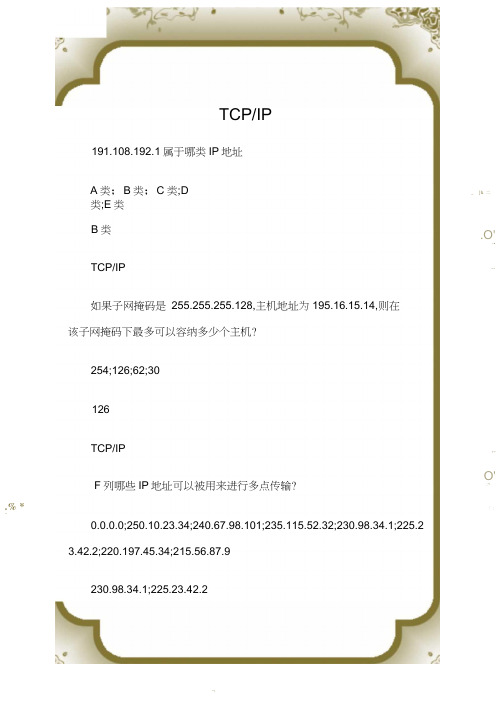
.% * 1LTCP/IP191.108.192.1属于哪类IP地址A类;B类;C类;D类;E类B类TCP/IP254;126;62;30126TCP/IP230.98.34.1;225.23.42.2如果子网掩码是255.255.255.128,主机地址为195.16.15.14,则在该子网掩码下最多可以容纳多少个主机?F列哪些IP地址可以被用来进行多点传输?0.0.0.0;250.10.23.34;240.67.98.101;235.115.52.32;230.98.34.1;225.23.42.2;220.197.45.34;215.56.87.9_ [I L二.O'L RJl J.1*^O'_'*l「:TCP/IPI.7 .% * 1L10.121;202.106.9.10;192.108 35;172.30.10.9172.30.10.9TCP/IP为:192.168.10.64;192.168.10.65;192.168.10.94;192.168.10.95192.168.10.64;192.168.10.95TCP/IP在局域网的建设中,哪些网段是我们可以使用的保留网段?224.0.0.0-239.0.0.0TCP/IP以下哪些地址不能用在互联网上* A 在一个网络中,一台主机的IP地址为:192.168.10.76,子网掩码255.255.255.224,在这个网段中,哪些地址不能分配给主机?10.0.0.0;172.16.0.0-172.31.0.0;192.168.0.0;224.0.0.0-239.0.0.0Ji尹_ [ 1 二.O'L 4Jl J-1*^ O'「:IJf T-7AI rJ:-47』I ■- .(* 1L172.16.20.5TCP/IPIP地址192.168.13.170/28的网段地址是168.13.160;192.168.13.160;TCP/IP多少202.114.18.255;202.114.18.12;202.114.18.11;202.114.18.8202.114.18.11TCP/IP一个TCP/IP的B类地址默认子网掩码是192.168.13.144;192.168.13.158;192.168.13.174;192.168.13.176;192.IP地址是202.114.18.10,掩码是255.255.255.252,其广播地址是Q.O'L 4Jl J-■輸1*^''cO''*1「:"K W'IJf T-7AI rJ:-47I ■- .(* 1L255.255.0.0;;/16;TCP/IP10.80.64.172/28;10.80.64.190/28TCP/IP地址?192.168.0.138TCP/IPF列地址中哪个属于本地回环地址教育局分配给某学校一网段地址为:10.80.64.128/25,该校有五个系,现要划分五个VLAN,请问以下哪些可用做VLAN的子网地址?10.80.64.128/26;10.80.64.172/28;10.80.64.190/28;10.80.64.144/28如果子网掩码为255.255.255.240,则以下哪个地址是合法的主机99.128.128.15;198.223.236.31;192.168.0.138;10.87.224.223;Q.O'L 4Jl J-■輸1*^''cO''*1「:"K W'*T一Jf T-XAI rJ:-47I ■- .(* 1LTh *回打灼,广r> 127.0.0.1TCP/IP是多少台?1024;65535;254;48254TCP/IPIP地址中网络号的作用有够进行通信的网络;指定被寻址的网中的某个节点指定了主机所属的网络TCP/IP175.15.28.5/19,请问它的子网掩码是对于一个没有经过子网划分的C类网络来说,允许安装的主机数指定了主机所属的网络;指定了网络上主机的标识;指定了设备能.O'L 4Jl J-■輸1*^''cO''*1「:"K W'Jf T-7』I ■- .(* 1L町勺-Th *回打灼,广r255.255.224.0TCP/IPF列属于私有地址的是:.1172. 16. 0. 1TCP/IPF列IP地址属于标准B类IP地址的是:172.16.5.1/24;190.168.1.1/16;120.10.1.1/16;10. 0. 0. 1/8190.168.1.1/16;120.10.1.1/16TCP/IP^^^^5.0.0;255.255.224.0;255.255.255.224;255.255.240.0192. 16. 159. 3;11. 172. 1. 98;172. 16. 0. 1;127. 0.有一个学校获得了一个C类网段的IP地址,要求你划分6个以上的子网,每个子网主机数不得少于30台,请问子网掩码该怎么写?Q.O'L 4Jl J-1*^''cO''*1「:Jf T-7』I ■- .(* 1LTh *回打灼,广r5. 255. 240. 0255. 255. 255. 224TCP/IP机直连,能否直接通信能;不能;能,但时断时通;以上都不对不能TCP/IP192.168.1.60/27,请问它的网络号和广播地址应该是:192.168.1.63;192.168.1.32 192.168.1.63192.168.1.32、192.168.1.63TCP/IP^^255.255. 255. 224;255 . 255 . 255 . 240;255. 255. 224. 0;25有两个IP地址192.168.1.14/28、192.168.1.17/28,请问这两台主192.168.1.0、192.168.1.255;192.168.1.32192.168.1.255;192.168.1.0Q.O'L 4Jl J-1*^''cO''*1「:*小T 弋;-IJfT-I - Ji" A I r』.(*1L对于一个没有经过子网划分的 C 类网络来说,允许安装的主机数 :hr.J给你一个B 类网172.16.0.0,子网掩码是255.255.255.192请问共 II 1-冷.O'L 4Jl J-I. 71*^''C O''SI..'L「:是多少台?1024;65535;254;48254TCP/IP有子网数和主机数分别是多少?512126;102462;256254;192128 102462TCP/IP子网掩码产生在那一层表示层;网络层;传输层;会话网络层TCP/IP*小T 弋;-IJf T-I -Ji"AI rI.7 』.(* 1L255.255.255.224流)某公司申请到一个C类IP地址,但要连接6个的子公司,的一个子公司有26台计算机,每个子公司在一个网段中,则子网掩码应设为255.255.255.0;255.255.255.128;255.255.255.192;255.255.255.224(本文档仅供参考用途,所载资料皆来自整理,欢迎大家分享交:hr.JII1-冷.O'L 4Jl J-1*^''CO''SI..'L「:。
计算机操作系统习题及答案(2)
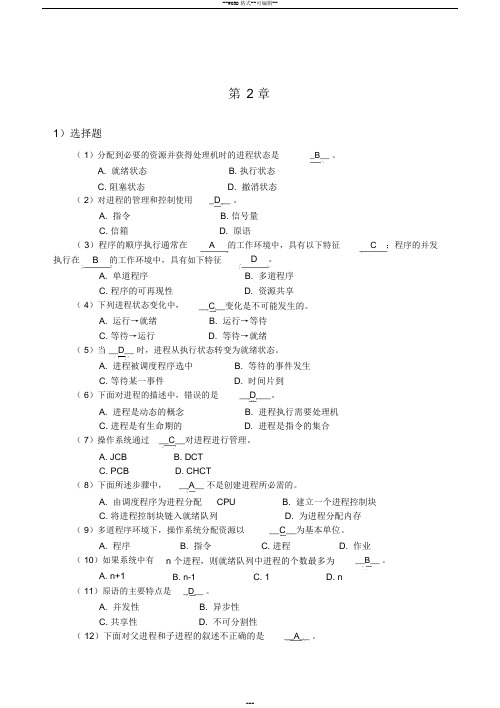
第2 章1)选择题( 1)分配到必要的资源并获得处理机时的进程状态是A. 就绪状态B. 执行状态C. 阻塞状态D. 撤消状态_B__ 。
( 2)对进程的管理和控制使用A. 指令C. 信箱_D__ 。
B. 信号量D. 原语( 3)程序的顺序执行通常在A 执行在B的工作环境中,具有如下特征的工作环境中,具有以下特征D。
C;程序的并发A. 单道程序C. 程序的可再现性B. 多道程序D. 资源共享( 4)下列进程状态变化中,__C__变化是不可能发生的。
A. 运行→就绪B. 运行→等待C. 等待→运行D. 等待→就绪( 5)当 __D__ 时,进程从执行状态转变为就绪状态。
A. 进程被调度程序选中B. 等待的事件发生C. 等待某一事件( 6)下面对进程的描述中,错误的是D. 时间片到__D___。
A. 进程是动态的概念C. 进程是有生命期的B. 进程执行需要处理机D. 进程是指令的集合( 7)操作系统通过__C__对进程进行管理。
A. JCBC. PCB( 8)下面所述步骤中,B. DCTD. CHCT__A__ 不是创建进程所必需的。
A. 由调度程序为进程分配CPUC. 将进程控制块链入就绪队列( 9)多道程序环境下,操作系统分配资源以B. 建立一个进程控制块D. 为进程分配内存__C__为基本单位。
A. 程序B. 指令C. 进程D. 作业( 10)如果系统中有n 个进程,则就绪队列中进程的个数最多为__B__ 。
A. n+1B. n-1C. 1D. n( 11)原语的主要特点是_D__ 。
A. 并发性C. 共享性B. 异步性D. 不可分割性( 12)下面对父进程和子进程的叙述不正确的是__A__ 。
A.父进程创建了子进程,因此父进程执行完了子进程才能运行B. 父进程和子进程之间可以并发C.父进程可以等待所有子进程结束后再执行D.撤消父进程之时,可以同时撤消其子进程( 13)下列关于进程的叙述中,最不符合操作系统对进程理解的是_A__ 。
混凝土习题及答案(2)
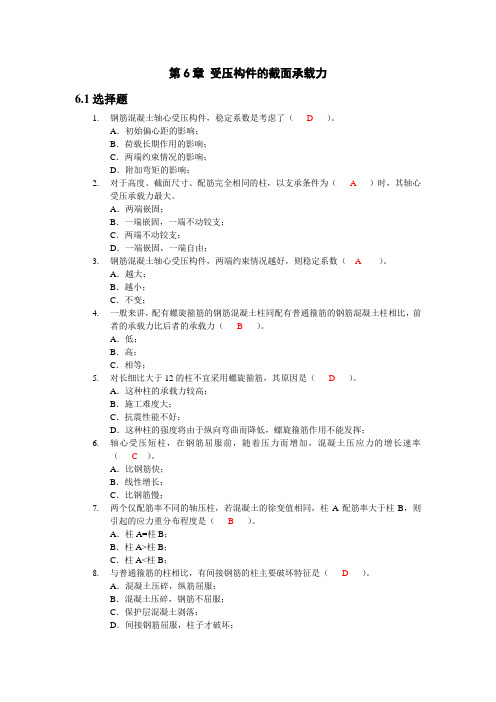
第6章受压构件的截面承载力6.1选择题1.钢筋混凝土轴心受压构件,稳定系数是考虑了( D )。
A.初始偏心距的影响;B.荷载长期作用的影响;C.两端约束情况的影响;D.附加弯矩的影响;2.对于高度、截面尺寸、配筋完全相同的柱,以支承条件为( A )时,其轴心受压承载力最大。
A.两端嵌固;B.一端嵌固,一端不动铰支;C.两端不动铰支;D.一端嵌固,一端自由;3.钢筋混凝土轴心受压构件,两端约束情况越好,则稳定系数(A)。
A.越大;B.越小;C.不变;4.一般来讲,配有螺旋箍筋的钢筋混凝土柱同配有普通箍筋的钢筋混凝土柱相比,前者的承载力比后者的承载力(B)。
A.低;B.高;C.相等;5.对长细比大于12的柱不宜采用螺旋箍筋,其原因是( D )。
A.这种柱的承载力较高;B.施工难度大;C.抗震性能不好;D.这种柱的强度将由于纵向弯曲而降低,螺旋箍筋作用不能发挥;6.轴心受压短柱,在钢筋屈服前,随着压力而增加,混凝土压应力的增长速率(C)。
A.比钢筋快;B.线性增长;C.比钢筋慢;7.两个仅配筋率不同的轴压柱,若混凝土的徐变值相同,柱A配筋率大于柱B,则引起的应力重分布程度是(B)。
A.柱A=柱B;B.柱A>柱B;C.柱A<柱B;8.与普通箍筋的柱相比,有间接钢筋的柱主要破坏特征是(D)。
A.混凝土压碎,纵筋屈服;B.混凝土压碎,钢筋不屈服;C.保护层混凝土剥落;D.间接钢筋屈服,柱子才破坏;9. 螺旋筋柱的核心区混凝土抗压强度高于fc 是因为( C )。
A .螺旋筋参与受压;B .螺旋筋使核心区混凝土密实;C .螺旋筋约束了核心区混凝土的横向变形;D .螺旋筋使核心区混凝土中不出现内裂缝;10. 有两个配有螺旋钢箍的柱截面,一个直径大,一个直径小,其它条件均相同,则螺旋箍筋对哪一个柱的承载力提高得大些( B )。
A .对直径大的;B .对直径小的;C .两者相同;11. 为了提高钢筋混凝土轴心受压构件的极限应变,应该( C )。
1017-习题作业-食品色素与着色剂 习题及答案(2)

食品色素与着色剂一、填空题 1 根据溶解性不同,天然色素可分为_______和_______两类。
2 天然色素根据化学结构可分为四吡咯衍生物类、异戊二烯衍生物类、多酚类等。
其中四吡咯衍生物类色素中重要的有_______、_______和_______。
3 肌红蛋白的蛋白质为_______。
4 动物肌肉的色泽主要是由于存在肌红蛋白和血红蛋白所致。
肌红蛋白和血红蛋白都是_______与_______结合而成的结合蛋白。
5 在腌肉制作过程中,亚硝酸盐和肌红蛋白发生反应生成_______,是未烹调腌肉中的最终产物,它再进一步的加热处理形成稳定的_______,这是加热腌肉中的主要色素。
6 亚硝酸盐在腌肉制品中的作用有_______、_______、_______。
7 叶绿素是_______溶性的,叶绿素a、b在自然界含量较高,高等植物中的叶绿素a:b=_______。
8 花青素是_______溶性的,胡萝卜素是_______溶性的。
9 类胡萝卜素按结构特征可分为_______和_______。
由C、H两种元素组成的类胡萝卜素称为_______,虾青素等含氧衍生物称为_______。
10 类胡萝卜素由于含有高度共轭不饱和结构,在高温、氧、氧化剂和光等影响因素的作用下,会发生分解褪色等变化,主要发生_______、_______、_______,使食品品质降低。
11 水分活度影响类胡萝卜素的自动氧化反应,在_______时,有利于类胡萝卜素的自动氧化反应,在_______的情况下抑制自动氧化反应。
12 在通常情况下,天然的类胡萝卜素是以_______构型存在的,在热加工过程以及光照和酸性条件下,都能导致_______。
13 花色苷的稳定性与其结构有关。
分子中的羟基数目增加则稳定性_______甲基化程度提高则稳定性_______,同样_______也有利于色素稳定。
14 花青素随OH增多,吸收波长_______移,_______增加,随甲氧基增多吸收波长_______移,_______增加。
机械制造工艺习题2及答案

一、填空题1.获得形状精度的方法有_轨迹法_、成形法、_展成法_。
2.主轴回转作纯径向跳动及漂移时,所镗出的孔是_椭圆__形。
3.零件的加工质量包括_加工精度_和_加工表面质量__。
4.表面残余_拉_(拉或压)应力会加剧疲劳裂纹的扩展。
5.车削加工时,进给量增加会使表面粗糙度_变大_。
6.切削液的作用有冷却、_润滑__、清洗及防锈等作用。
7.在受迫振动中,当外激励频率近似等于系统频率时,会发生_共振_现象8.刀具静止参考系的建立是以切削运动为依据,其假定的工作条件包括假定运动条件和假定安装条件。
9.磨削加工的实质是磨粒对工件进行_刻划_、__滑擦(摩擦抛光)和切削三种作用的综合过程。
10.产品装配工艺中对“三化”程度要求是指结构的标准化、通用化和系列化。
11.尺寸链的特征是_关联性和_封闭性_。
12.零件光整加工的通常方法有_珩磨_、研磨、超精加工及_抛光_等方法。
13.机械加工工艺规程实际上就是指规定零件机械加工工艺过程和操作方法等的_工艺文件14.工艺过程是指生产过程中,直接改变生产对象形状、尺寸、相对位置、及性质的过程。
15.零件的几何精度、表面质量、物理机械性能是评定机器零件质量的主要指标。
16.加工经济精度是指在正常加工条件下(采用符合标准的设备,工艺装备和标准技术等级的工人,不延长加工时间)所能保证的加工精度。
17.工艺系统的几何误差主要加工方法的原理误差、制造和磨损所产生的机床几何误差和传动误差,调整误差、工件的安装误差、刀具、夹具和量具由于的制造误差与磨损引起。
18.轴类零件加工中常用两端中心孔作为统一的定位基准。
19.零件的加工误差指越小(大),加工精度就越高(低)。
20.粗加工阶段的主要任务是获得高的生产率。
21.工艺系统的几何误差包括加工方法的原理误差、制造和磨损所产生的机床几何误差和传动误差,调整误差、刀具、夹具和量具的制造误差、工件的安装误差。
22.精加工阶段的主要任务是使各主要表面达到图纸规定的质量要求。
基础化学实验(二)习题及答案二
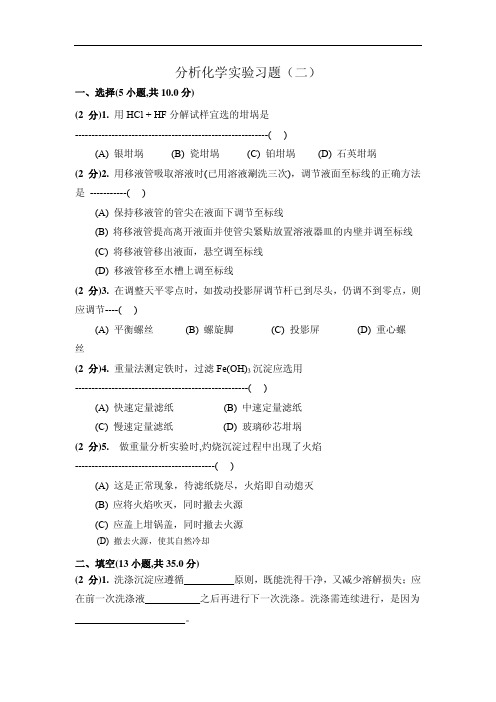
分析化学实验习题(二)一、选择(5小题,共10.0分)(2 分)1. 用HCl + HF分解试样宜选的坩埚是----------------------------------------------------------()(A) 银坩埚(B) 瓷坩埚(C) 铂坩埚(D) 石英坩埚(2 分)2. 用移液管吸取溶液时(已用溶液涮洗三次),调节液面至标线的正确方法是-----------()(A) 保持移液管的管尖在液面下调节至标线(B) 将移液管提高离开液面并使管尖紧贴放置溶液器皿的内壁并调至标线(C) 将移液管移出液面,悬空调至标线(D) 移液管移至水槽上调至标线(2 分)3. 在调整天平零点时,如拨动投影屏调节杆已到尽头,仍调不到零点,则应调节----()(A) 平衡螺丝(B) 螺旋脚(C) 投影屏(D) 重心螺丝(2 分)4. 重量法测定铁时,过滤Fe(OH)3沉淀应选用----------------------------------------------------()(A) 快速定量滤纸(B) 中速定量滤纸(C) 慢速定量滤纸(D) 玻璃砂芯坩埚(2 分)5. 做重量分析实验时,灼烧沉淀过程中出现了火焰------------------------------------------()(A) 这是正常现象,待滤纸烧尽,火焰即自动熄灭(B) 应将火焰吹灭,同时撤去火源(C) 应盖上坩锅盖,同时撤去火源(D) 撤去火源,使其自然冷却二、填空(13小题,共35.0分)(2 分)1. 洗涤沉淀应遵循__________原则,既能洗得干净,又减少溶解损失;应在前一次洗涤液___________之后再进行下一次洗涤。
洗涤需连续进行,是因为______________________。
(2 分)2. 下列试样用什么试剂溶解或分解:(1) 银合金____________________________________________ ;(2) 钠长石(NaAlSi3O8)中SiO2的测定________________________。
电机与变压器 练习册 习题 答案2
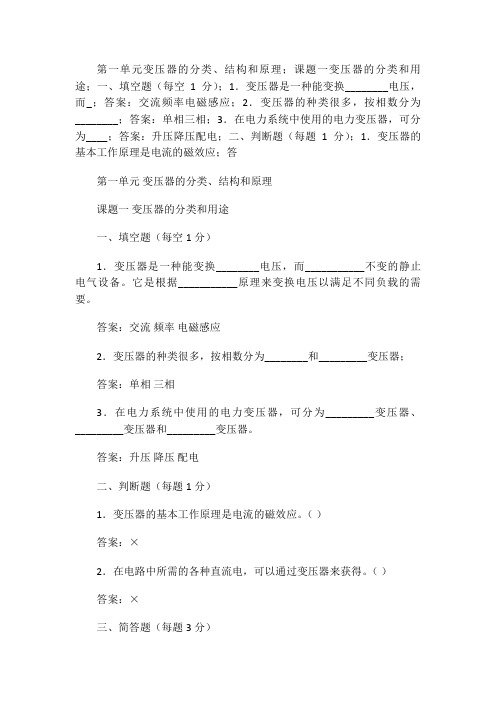
第一单元变压器的分类、结构和原理;课题一变压器的分类和用途;一、填空题(每空1分);1.变压器是一种能变换________电压,而_;答案:交流频率电磁感应;2.变压器的种类很多,按相数分为________;答案:单相三相;3.在电力系统中使用的电力变压器,可分为____;答案:升压降压配电;二、判断题(每题1分);1.变压器的基本工作原理是电流的磁效应;答第一单元变压器的分类、结构和原理课题一变压器的分类和用途一、填空题(每空1分)1.变压器是一种能变换________电压,而___________不变的静止电气设备。
它是根据___________原理来变换电压以满足不同负载的需要。
答案:交流频率电磁感应2.变压器的种类很多,按相数分为________和_________变压器;答案:单相三相3.在电力系统中使用的电力变压器,可分为_________变压器、_________变压器和_________变压器。
答案:升压降压配电二、判断题(每题1分)1.变压器的基本工作原理是电流的磁效应。
()答案:×2.在电路中所需的各种直流电,可以通过变压器来获得。
()答案:×三、简答题(每题3分)1、为什么要高压送电答案:当输出电功率一定时,电压越大,电流越小。
2(1)P损 = IR,可以减少运输中的损耗。
(2)可以节约架设成本。
2、变压器能改变直流电压吗如接上直流电压,会发生什么现象答案:不能。
如果接上直流电压,会使绕组过热而烧毁。
课题二变压器的结构与冷却方式一、填空题(每空1分)1.变压器的铁心常用_________叠装而成,因线圈位置不同,可分成_________和_________两大类。
答案:硅钢片芯式壳式2.变压器的绕组常用绝缘铜线或铜箔绕制而成。
接电源的绕组称为____________;接负载的绕组称为___________。
也可按绕组所接电压高低分为___________和___________。
系统建模与仿真习题2及答案

系统建模与仿真习题二及答案1. 考虑如图所示的典型反馈控制系统框图(1)假设各个子传递函数模型为66.031.05.02)(232++-+=s s s s s G ,s s s G c 610)(+=,21)(+=s s H 分别用feedback ()函数以及G*Gc/(1+G*Gc*H)(要最小实现)方法求该系统的传递函数模型。
(2) 假设系统的受控对象模型为s e s s s G 23)1(12)(-+=,控制器模型为 ss s G c 32)(+=,并假设系统是单位负反馈,分别用feedback ()函数以及G*Gc/(1+G*Gc*H)(要最小实现)方法能求出该系统的传递函数模型?如果不能,请近似该模型。
解:(1)clc;clear;G=tf([2 0 0.5],[1 -0.1 3 0.66]);Gc=tf([10 6],[1 0]);H=tf(1,[1 2]);G1=feedback(G*Gc,H)G2=G*Gc/(1+G*Gc*H)Gmin=minreal(G2)结果:Transfer function:20 s^4 + 52 s^3 + 29 s^2 + 13 s + 6s^5 + 1.9 s^4 + 22.8 s^3 + 18.66 s^2 + 6.32 s + 3Transfer function:20 s^8 + 50 s^7 + 83.8 s^6 + 179.3 s^5 + 126 s^4 + 57.54 s^3 + 26.58 s^2 + 3.96 ss^9 + 1.8 s^8 + 25.61 s^7 + 22.74 s^6 + 74.11 s^5 + 73.4 s^4 + 30.98 s^3+ 13.17 s^2 + 1.98 s Transfer function:20 s^4 + 52 s^3 + 29 s^2 + 13 s + 6s^5 + 1.9 s^4 + 22.8 s^3 + 18.66 s^2 + 6.32 s + 3(2)由于s c e s s s s G s G 232)1(3624)(*)(-++= 方法1:将s e 2-转换为近似多项式。
- 1、下载文档前请自行甄别文档内容的完整性,平台不提供额外的编辑、内容补充、找答案等附加服务。
- 2、"仅部分预览"的文档,不可在线预览部分如存在完整性等问题,可反馈申请退款(可完整预览的文档不适用该条件!)。
- 3、如文档侵犯您的权益,请联系客服反馈,我们会尽快为您处理(人工客服工作时间:9:00-18:30)。
第三章 消费者行为理论
2. 假设某消费者的均衡如图3—1(即教材中第96页的图3—22)所示。
其中,横轴OX 1和纵轴OX 2分别表示商品1和商品2的数量,线段AB 为消费者的预算线,曲线
图3—1 某消费者的均衡
U 为消费者的无差异曲线,E 点为效用最大化的均衡点。
已知商品1的价格P 1=2元。
(1)求消费者的收入;
(2)求商品2的价格P 2;
(3)写出预算线方程;
(4)求预算线的斜率;
(5)求E 点的MRS 12的值。
解答:(1)图中的横截距表示消费者的收入全部购买商品1的数量为30单位,且已知P 1=2元,所以,消费者的收入M =2元×30=60元。
(2)图中的纵截距表示消费者的收入全部购买商品2的数量为20单位,且由(1)已知收入
M =60元,所以,商品2的价格P 2=M 20=6020=3元。
(3)由于预算线方程的一般形式为 P 1X 1+P 2X 2=M 所以,由(1)、(2)可将预算线方程具体写为:
2X 1+3X 2=60。
(4)将(3)中的预算线方程进一步整理为X 2=-23X 1+20。
很清楚,预算线的斜率为-23。
(5)在消费者效用最大化的均衡点E 上,有MRS 12=P 1P 2
,即无差异曲线斜率的绝对值即MRS 等于预算线斜率的绝对值P 1P 2。
因此,MRS 12=P 1P 2=23。
5. 已知某消费者每年用于商品1和商品2的收入为540元,两商品的价格分别为P 1=20元和P 2=30元,该消费者的效用函数为U =3X 1X 22,该消费者每年购买这两种商品的数量应各是多少?每年从中获得的总效用是多少?
解答:根据消费者的效用最大化的均衡条件
MU 1MU 2=P 1P 2
其中,由U =3X 1X 22可得 MU 1=d TU d X 1=3X 22; MU 2=d TU d X 2
=6X 1X 2 于是,有 3X 226X 1X 2=2030 整理得 X 2=43
X 1 (1) 将式(1)代入预算约束条件20X 1+30X 2=540,得
20X 1+30·43
X 1=540 解得 X 1=9 将X 1=9代入式(1)得 X 2=12因此,该消费者每年购买这两种商品的数量应该为X 1=9 ;X 2=12。
将以上最优的商品组合代入效用函数,得U *=3X *1(X *2)2=3×
9×122=3888 它表明该消费者的最优商品购买组合给他带来的最大效用水平为3 888。
6. 假设某商品市场上只有A 、B 两个消费者,他们的需求函数各自为Q d A =20-4P 和Q d B =30-5P 。
(1)列出这两个消费者的需求表和市场需求表。
(2)根据(1),画出这两个消费者的需求曲线和市场需求曲线。
解答:(1)由消费者A 的需求函数Q d A =20-4P ,可编制消费者A 的需求表;由消费者B
的需求函数Q d B =30-5P ,可编制消费B 的需求表。
至于市场的需求表的编制可以使用两种方法,一种方法是利用已得到消费者A 、B 的需求表,将每一价格水平上两个消费者的需求数量加总来编制市场需求表;另一种方法是先将消费者A 和B 的需求函数加总来求得市场
需求函数,即市场需求函数Q d =Q d A +Q d B =(20-4P )+(30-5P )=50-9P , 然后运用所得到
的市场需求函数Q d =50-9P 来编制市场需求表。
这两种方法所得到的市场需求表是相同的。
按以上方法编制的3张需求表如下所示。
消费者A 的需求表
,消费者B 的需求表
,市场的需求表
(2)由(1)中的3线如图3—4所示。
图3—4
在此,需要特别指出的是,市场需求曲线有一个折点,该点发生在价格P =5和需求量Q d =5的坐标点位置。
关于市场需求曲线的这一特征,可以从两个角度来解释:一个角度是从图形来理解,市场需求曲线是市场上单个消费者需求曲线的水平加总,即在P ≤5的范围,市场需求曲线由两个消费者需求曲线水平加总得到;而当P >5时,只有消费者B 的需求曲线发生作用,所以,他的需求曲线就是市场需求曲线。
另一个角度是从需求函数看,在P ≤5
的范围,市场需求函数Q d =Q d A +Q d B =50-9P 成立;而当P >5时,只有消费者B 的需求函
数才构成市场需求函数,即Q d =Q d B =30-5P 。
7. 假定某消费者的效用函数为852831x x U =,两商品的价格分别为P 1,P 2,消费者的收入为M 。
分别求该消费者关于商品1和商品2的需求函数。
解答:根据消费者效用最大化的均衡条件
2
121P P MU MU = (1) 其中,由已知的效用函数85283
1x x U =可得 852*******x x x U MU -=∂∂= (2); 83
2831228
5-=∂∂=x x x U MU (3) 由(1)、(2)、(3)得211253P P x x =, 即2
11235P x P x = (4), 且知约束条件M x P x P =+2211(5)
,结合(4)(5)求得该消费者关于两商品的需求函数为
11.已知某消费者的效用函数为U =X 1X 2,两商品的价格分别为P 1=4,P 2=2,消费者的收入是M =80。
现在假定商品1的价格下降为P 1=2。
求:(1)由商品1的价格P 1下降所导致的总效应,使得该消费者对商品1的购买量发生多少变化?
(2)由商品1的价格P 1下降所导致的替代效应,使得该消费者对商品1的购买量发生多少变化?
(3)由商品1的价格P 1下降所导致的收入效应,使得该消费者对商品1的购买量发生多少变化?
解答:利用图3—7解答此题。
在图3—7中,当P 1=4,P 2=2时,消费者的预算线为AB ,效用最大化的均衡点为a 。
当P 1=2,P 2=2时,消费者的预算线为AB ′,效用最大化的均衡点为b 。
图3—7
(1)先考虑均衡点a 。
根据效用最大化的均衡条件212112P P MU MU MRS ==(1),由效用函数U =X 1X 2 ,知1221;X MU X MU ==,并且知道P 1=4,P 2=2,结合消费者效用最大化的均衡条件得212
1X X =(2);消费者的预算约束条件为)3(802421=+X X ,结合(2)(3)求得消费者均衡时两种商品的最优消费组合为:20;1021==X X 。
此时的最优效用水平为:U =X 1X 2=10×20=200
再考虑均衡点b 。
当商品1的价格下降为P 1=2时,根据效用最大化的均衡条件
2
12112P P MU MU MRS ==
,得21X X =(4);消费者的预算约束条件为:802221=+X X (5),结合(4)(5)求得消费者均衡时两种商品的最优消费组合为:2021==X X 。
从a 到b 商品1的购买量变化为:△X 1=20-10=10,这就是商品1价格下降所引起的消费量变化的总效应。
(2)为了分析替代效应,作一条平行于预算线AB′且与无差异曲线U 1相切于c 点的补偿预算线FG 。
在均衡点c ,根据效用最大化的均衡条件212112P P MU MU MRS ==并且知道P 1=2,P 2=2,求得X 1=X 2。
将X 1=X 2代入效用约束等式U =X 1X 2=200,解得X 1=14,X 2=14(保留整数)。
从a 点到c 点的商品1的数量变化为△X 1=14-10=4,这就是P 1变化引起的商品1消费量变化的替代效应。
(3)至此可得,从c 点到b 点的商品1的数量变化为△X 1=20-14=6,这就是P 1变化引起的商品1消费量变化的收入效应。
